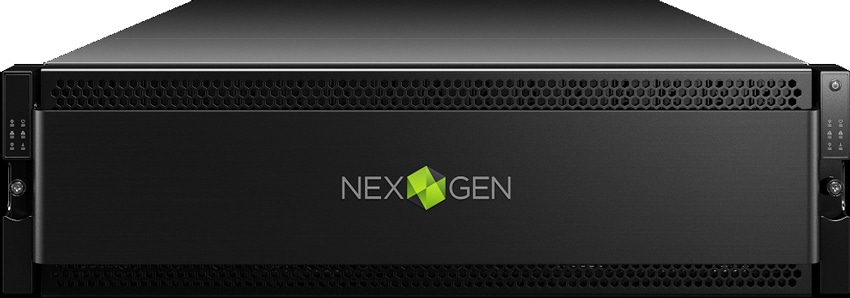Today NexGen Storage announced the industry’s first multi-tier all-flash array (AFA) that leverages its patented Quality of Service (QoS). NexGen has two new AFA, the N5-1500 and N5-3000, both of which utilizes multiple tiers of flash including RAM, PCIe flash, and SSDs. NexGen uses its recently patented QoS (Primary Data Storage System with Quality of Service, US Patent # 9,176,708) to give customers high performance and predictability while avoiding latency spikes.

Flash prices are continuing to drop and even the lower performing SSDs out perform most HDDs. AFAs are becoming more attractive to customers but first time customers are surprised when they encounter latency spikes. There are several reasons why this might happen from the effects of complex deduplication algorithms, cache overflows, SAS controller bottlenecks, overworked CPUs, to other system constraints. NexGen looks to address this issue with its new arrays and patented QoS.
The N5-1500 and N5-3000 with Storage QoS are ideal for mission critical environments. Combining the AFAs with the new QoS will deliver predictable high performance and low latency which is especially beneficial for storage for virtual servers, large scale VDI, and database applications. The new AFAs have data reduction technologies that NexGen claims will extend the life of the SSDs 4 times, increase performance by 2.5 times, and twice the data reduction ration without impacting performance. The new arrays are also future-proofed by supporting upcoming technology such as NVMe, 3D Flash, and ReRAM.
The NexGen flash array data management software is comprised of the patented QoS. The QoS enables users to setup teiring, caching, and automatically setup performance for given workloads. This means more workloads can be consolidated while mission-critical applications get the performance they need. The QoS engine is hardware agnostic to work with future and new flash storage as it is needed. And the QoS moves data directly from the network to multiple types of memory and across numerous paths in parallel to eliminate contention and latency spikes associated with hardware/controller adapters.
Key capabilities of the new QoS include:
- Targets with Automated Throttling. NexGen’s patented QoS simplifies performance management by using a statistics database to monitor all workloads in real time, automatically throttles lower priority workloads as needed and relieves customers from the burden of the guesswork associated with manual minimum, maximum and burst settings. NexGen’s patented approach simplifies management versus traditional QoS offerings that force users to predict which neighbor is going to be noisy or wait until a neighbor becomes noisy, then manually throttling it by changing minimum, maximum and burst settings. The latter approach requires users to predict future workloads and guess how much to throttle, which is nearly impossible to do.
- Priorities and the Ability to Over-Provision System Performance. Just like thin provisioning, the ability to over-provision performance is required for maximum utilization of resources. NexGen’s dynamic QoS allows users to prioritize between the various performance targets during times of system resource contention so that the storage system makes the right trade-offs to ensure mission-critical applications get consistent performance. This approach differs from other QoS offerings that are limited to manual minimum, maximum and burst settings that cannot determine which workload should take priority and thus cannot simultaneously allow overprovisioning and guarantee mission-critical application SLAs. The ability to overprovision resources is especially critical to Service Providers who need to achieve maximum resource utilization while meeting SLAs.
- Optimal Data Placement. With the proliferation of new types of non-volatile media, including several different types of flash, the only way to ensure that organizations achieve the most affordable all-flash system while avoiding latency spikes and contention is through the use of multi-tier flash arrays managed with a dynamic QoS engine. NexGen’s QoS prioritizes data placement in real-time to ensure that policies are met and end-user expectations are exceeded. NexGen’s approach differs from first generation all-flash arrays that were designed for a single type of flash that treats all data equally and doesn’t protect mission-critical applications from unexpected latency spikes.
- VMware vSphere Virtual Volume (VVol) Integration. NexGen’s patented QoS is especially important for customers considering using VMware vSphere 6 with Virtual Volumes (VVols). In these environments, automated, dynamic policy setting is essential to scale since VVols can increase the number of objects in a data storage system by up to 30 times. Manually defining and entering minimum, maximum and burst settings for each object is burdensome and complex. NexGen’s QoS policies are integrated with VMware VVols to radically simplify VM-level performance management and make changing performance policies as simple as changing a selection on the drop down menu.




 Amazon
Amazon